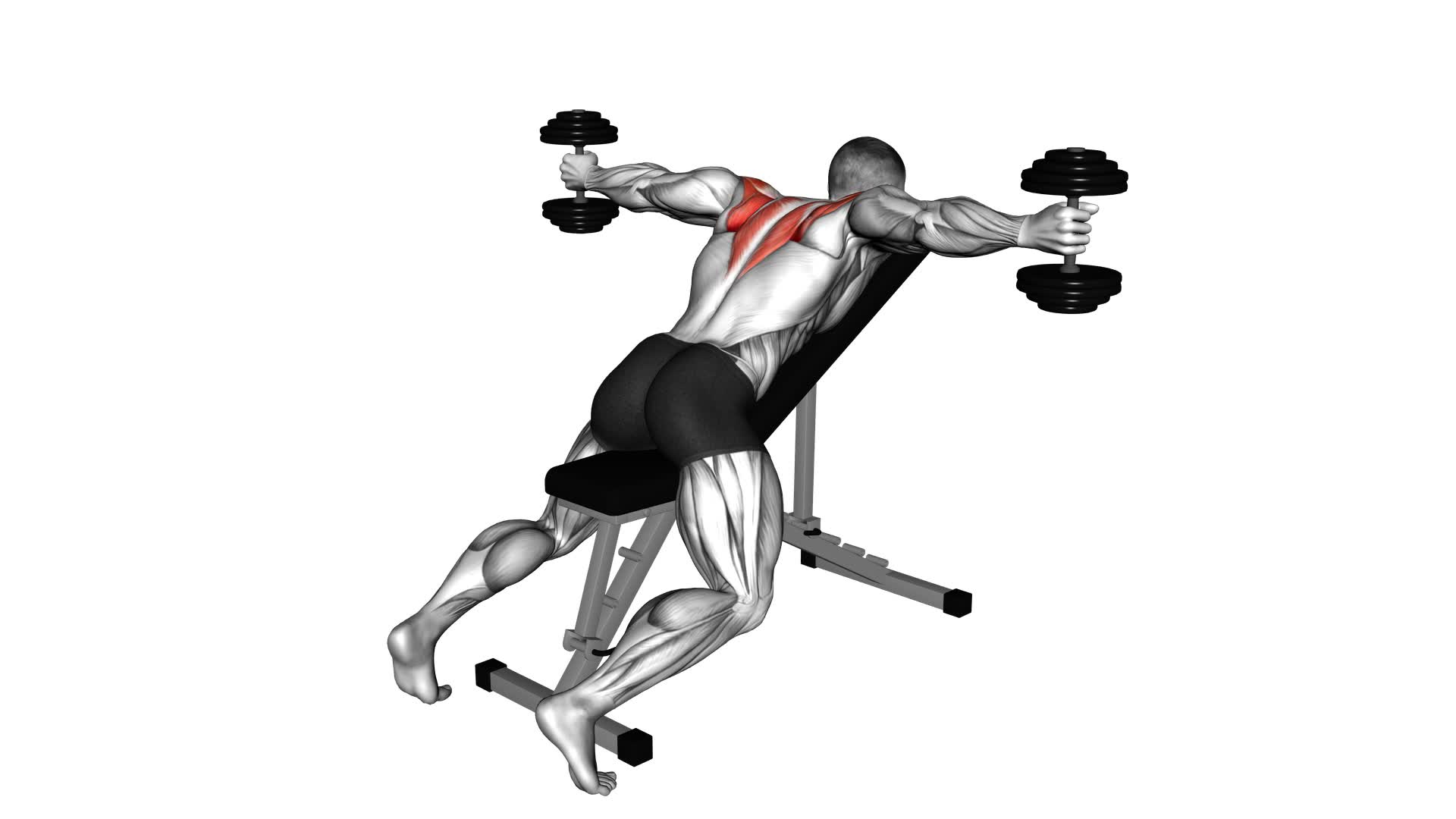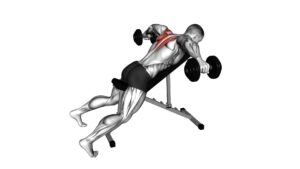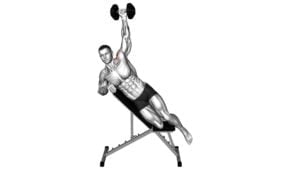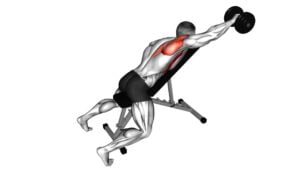Dumbbell Incline T Raise – Video Exercise Guide & Tips

Are you looking for an effective upper body exercise that targets your shoulders?
Watch This Exercise Video
Look no further than the Dumbbell Incline T Raise. This exercise is perfect for strengthening and sculpting your shoulder muscles.
In this video exercise guide, you'll learn the proper form and technique, as well as variations and progressions to challenge yourself. Avoid common mistakes and get tips for an effective workout.
Get ready to take your shoulder workout to the next level with this informative guide.
Key Takeaways
- Targets and activates upper back and shoulder muscles
- Improves strength and muscle development in targeted areas
- Enhances posture and reduces the risk of postural issues
- Beneficial for athletes involved in sports requiring overhead movements
Benefits of the Dumbbell Incline T Raise
To understand the benefits of the Dumbbell Incline T Raise, you need to focus on your upper back and shoulder muscles. This exercise is highly effective for targeting and activating these muscle groups. One of the main benefits of performing the Dumbbell Incline T Raise is the increased muscle activation it provides. By lifting the dumbbells in a T shape while on an incline bench, you engage your upper back and shoulder muscles to a greater extent compared to other exercises. This leads to improved strength and muscle development in these areas.
In addition to muscle activation, the Dumbbell Incline T Raise also helps to improve your posture. As you strengthen your upper back and shoulder muscles, you naturally pull your shoulders back and stand taller. This not only enhances your physical appearance but also reduces the risk of developing postural issues and pain.
By incorporating the Dumbbell Incline T Raise into your workout routine, you can experience the benefits of increased muscle activation in your upper back and shoulder muscles, leading to improved strength and posture.
Now that you understand the benefits, let's move on to discussing the proper form and technique for performing this exercise.
Proper Form and Technique
Mastering the proper form and technique for the Dumbbell Incline T Raise requires focusing on the correct execution of the exercise. To ensure you're performing this exercise correctly, follow these steps:
- Start by setting an incline bench at a 45-degree angle and grasping a dumbbell in each hand.
- Lie face down on the bench with your chest and stomach firmly pressed against it.
- Extend your arms straight down towards the floor, palms facing each other.
- Keeping your arms straight, lift the dumbbells out to the sides until they're parallel to the floor, forming a T shape with your body.
Proper form and technique are essential for maximizing muscle activation and range of motion during the Dumbbell Incline T Raise. By maintaining a neutral spine and engaging your core muscles, you can ensure optimal muscle activation in your shoulders, upper back, and rear delts.
It's crucial to focus on the full range of motion, making sure to raise the dumbbells as high as possible without swinging or using momentum. Remember to keep your arms straight throughout the exercise and avoid any excessive arching or shrugging of the shoulders.
Variations and Progressions
Once you have mastered the proper form and technique for the Dumbbell Incline T Raise, you can explore various variations and progressions to challenge your muscles further. To add more difficulty to this exercise, you can increase the weight of the dumbbells you're using. This will require your muscles to work harder and will help to build strength and definition in your shoulders and upper back.
Another advanced modification you can try is performing the exercise on a stability ball instead of an incline bench. This will engage your core muscles even more as you work to stabilize yourself on the unstable surface. It's important to note that this variation requires a good level of stability and balance, so it's recommended for those who've already built a solid foundation with the basic exercise.
In terms of equipment recommendations, it's advisable to use dumbbells that are heavy enough to challenge you but still allow you to maintain proper form throughout the exercise. It may be helpful to have a range of dumbbell weights available, so you can gradually increase the resistance as you become stronger.
Common Mistakes to Avoid
You should regularly check for and avoid common mistakes when performing the Dumbbell Incline T Raise exercise. Proper technique is crucial to maximize the benefits and minimize the risk of injury. Here are some common mistakes to watch out for:
- Using too much weight: It's important to choose a weight that allows you to maintain proper form throughout the exercise. Using weights that are too heavy can lead to improper posture and strain on the muscles.
- Rounded shoulders: One common mistake is allowing the shoulders to round forward during the movement. To avoid this, focus on keeping your shoulders pulled back and down throughout the exercise.
- Lifting with the arms: The primary focus of the Dumbbell Incline T Raise is to target the muscles in the upper back. Avoid using excessive arm strength and instead, engage the back muscles to perform the movement.
- Swinging the body: Another common mistake is using momentum to swing the dumbbells up. This reduces the effectiveness of the exercise and can put strain on the lower back. Make sure to perform the movement in a controlled manner, using the muscles rather than momentum.
Tips for an Effective Workout
To ensure an effective workout and maximize your results, it's important to incorporate these tips into your Dumbbell Incline T Raise routine.
First and foremost, warm-up exercises are crucial before starting any workout. They help increase blood flow to your muscles, loosen up joints, and reduce the risk of injury. Spend about 5-10 minutes doing light cardio exercises like jogging or cycling, followed by dynamic stretches that target the muscles you'll be working on.
Another key aspect of an effective workout is tracking your progress and setting goals. Keeping a workout journal or using a fitness tracking app can help you monitor your performance and stay motivated. Set specific, realistic goals for your Dumbbell Incline T Raise routine, such as increasing the weight lifted or the number of repetitions performed. By tracking your progress and challenging yourself with new goals, you can continuously push your limits and make consistent improvements.
In addition to warm-up exercises and goal setting, it's important to maintain proper form throughout your Dumbbell Incline T Raise routine. This means keeping your back straight, engaging your core, and focusing on the targeted muscles. Avoid using momentum or swinging your arms to lift the dumbbells. Instead, move slowly and controlled, emphasizing the contraction of your shoulder and upper back muscles.
Frequently Asked Questions
How Many Repetitions Should I Do for the Dumbbell Incline T Raise Exercise?
For the dumbbell incline T raise exercise, the optimal repetition range can vary depending on your fitness level and goals. Generally, aim for 8-12 repetitions per set to challenge your muscles and promote strength and muscle growth.
However, if you're a beginner, start with lighter weights and higher repetitions.
To add variation and modify the exercise, you can try using different hand positions, adjusting the incline angle, or incorporating pauses at the top of the movement to increase the intensity.
Can I Use Resistance Bands Instead of Dumbbells for This Exercise?
Yes, you can certainly use resistance bands instead of dumbbells for the dumbbell incline T raise exercise.
Resistance bands provide a different form of resistance and can help target your muscles in a unique way.
However, it's important to note that using dumbbells has its own benefits, such as increased stability and the ability to progressively overload the muscles.
Ultimately, the choice between resistance bands and dumbbells depends on your personal preference and fitness goals.
Is It Necessary to Perform This Exercise on an Incline Bench, or Can I Do It on a Flat Bench?
Is it effective to do the dumbbell incline T raise on a stability ball instead of a bench? Can I do the dumbbell incline T raise with a barbell instead of dumbbells?
When it comes to the dumbbell incline T raise, using an incline bench is necessary for optimal results. The incline bench provides a greater range of motion and targets the upper back and shoulders more effectively.
Using a stability ball or a barbell may not provide the same level of stability and control, potentially compromising the exercise's effectiveness and increasing the risk of injury.
Should I Perform This Exercise at the Beginning or the End of My Workout Routine?
Should you perform the dumbbell incline T raise before or after your cardio session?
The timing of this exercise depends on your goals and preferences.
Performing it before cardio can help activate and warm up your upper back muscles, preparing them for the workout ahead.
On the other hand, doing it after cardio can be a great way to finish off your upper body routine and target those muscles when they're already fatigued.
Ultimately, it's up to you to decide what works best for your fitness routine.
Can I Incorporate the Dumbbell Incline T Raise Into a Full-Body Workout, or Is It Better to Focus on Specific Muscle Groups?
When deciding between a full-body workout or focusing on specific muscle groups, it's important to consider your goals and preferences.
Full-body workouts can provide overall strength and cardiovascular benefits, while muscle-specific workouts target specific areas for more focused development.
Incorporating compound exercises, like the dumbbell incline T raise, in a full-body routine can offer the best of both worlds. These exercises engage multiple muscle groups, increasing efficiency and enhancing functional movement patterns.
Conclusion
In conclusion, the dumbbell incline T raise is a highly effective exercise for targeting the muscles in your shoulders and upper back.
By maintaining proper form and technique, you can maximize the benefits of this exercise and avoid common mistakes.
Additionally, incorporating variations and progressions can help you continue challenging your muscles and making progress.
Remember to follow these tips for an effective workout and enjoy the benefits of this exercise in your fitness routine.

Author
Years ago, the spark of my life’s passion ignited in my mind the moment I stepped into the local gym for the first time. The inaugural bead of perspiration, the initial endeavor, the very first surge of endorphins, and a sense of pride that washed over me post-workout marked the beginning of my deep-seated interest in strength sports, fitness, and sports nutrition. This very curiosity blossomed rapidly into a profound fascination, propelling me to earn a Master’s degree in Physical Education from the Academy of Physical Education in Krakow, followed by a Sports Manager diploma from the Jagiellonian University. My journey of growth led me to gain more specialized qualifications, such as being a certified personal trainer with a focus on sports dietetics, a lifeguard, and an instructor for wellness and corrective gymnastics. Theoretical knowledge paired seamlessly with practical experience, reinforcing my belief that the transformation of individuals under my guidance was also a reflection of my personal growth. This belief holds true even today. Each day, I strive to push the boundaries and explore new realms. These realms gently elevate me to greater heights. The unique combination of passion for my field and the continuous quest for growth fuels my drive to break new ground.







